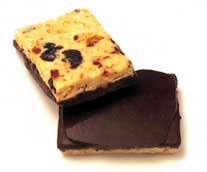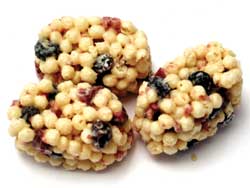
Over time, the bar's proteins absorb moisture. The result, a hard, less-tasteful bar, is unappealing to consumers and results in lost business. To help manufacturers remedy this problem, Arla Foods (headquartered in Denmark, with American offices in Union, N.J.) recently launched in the U.S. Multilac DI-8620, a milk protein made specifically for protein bars. It improves stability and reduces a protein bar's tendency to become hard. Additionally, when used in applications up to 30% protein, it has a milky, sweet taste with no off flavors, according to the manufacturer.
Since protein bar systems have a small quantity of water—only about 10%, coupled with a 30-50% protein content and relatively little fat—this results in little moisture available to dissolve the ingredients in the bar. The standard protein bar follows the 30/40/30 rule: 30 calories from protein, 40 calories from carbohydrates and 30 calories from fat.
“It's tough to make the moisture and sugar systems work so that you don't get the powdery mouthfeel of the protein. The water might be equally divided between the protein and sugar systems [to start with], but the sugar system will give up the water, will crystallize, and the protein will absorb the water,” explains Ulla Petersen Skytte, business development. Water activity drops because the protein absorbs the water, resulting in bar hardening.

Hydrophobic Qualities
The product is available as a powder that is mixed in with the ingredients before the bar is extruded. The powder requires no extra or special handling, but should be thoroughly incorporated into the bar mix in order to avoid migration problems. “The protein has hydrophobic qualities and won't allow the proteins to absorb water to the same extent as other products. The combination of the right kinds of proteins helps those in the bar reject water, keeping it softer for a longer period of time,” explains Petersen Skytte. The milk protein also possesses the ability to slightly aerate a bar, creating a lighter product. However, its main functions continue to be stability, and then taste.While Multilac has been on the market for some time, it recently has been made kosher, a new approach for Arla in the American market. “Being kosher was very important to our American customers, so we are pleased to be able to offer this product to them now,” states Petersen Skytte.
The company's preliminary data shows the milk protein is stable for well beyond six months, although the company is working on shelflife studies that prove it can last for a full year; those reports are to be published by year's end. While the industry standard is a year, those who eat protein bars well know a bar can be hard before the date of expiration. “A half year is very acceptable. After two weeks, you can tell if you are on the right track. Once the balance is right, the product will be very stable,” explains Petersen Skytte.
For more information:
Joyce Stefan at 908-964-4420
joyce.stefan@arlafoods.com
www.arlafoodsingredients.com
Arla Foods Write in 402